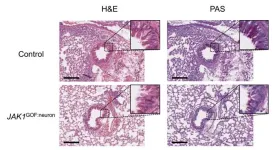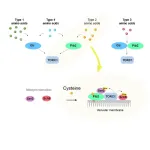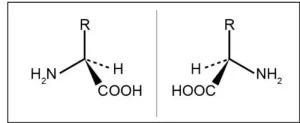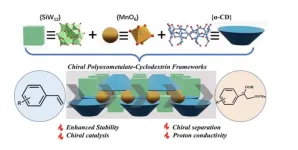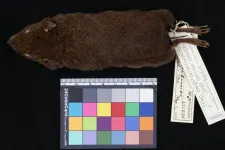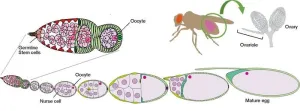JAK1 is a key protein in the body that supports cell communication and controls the immune system. It is part of a group of proteins that pass signals from a cell’s exterior to its interior. Controlling JAK1 activity is also important in managing conditions such as rheumatoid arthritis and some cancers.
Current JAK inhibitors work well against inflammation in diseases like eczema, but the study suggests a need for a nuanced approach in modulating JAK activity for conditions like asthma. The potential shift toward enhancing, rather than blocking, JAK activity in lung neurons could be a transformative strategy, distinct from traditional JAK inhibitors that mainly target immune cells, say the investigators.
As part of the work, a mouse made with a patient-specific mutation in the gene for JAK1 revealed how this mutant protein causes disease and how it could potentially be harnessed for broader therapeutic use. The study showed that activated JAK1 signaling has tissue-specific effects, including an unexpected immunoregulatory role in lung sensory neurons, where it suppresses lung inflammation.
“This may explain why JAK1-selective inhibitors, while highly successful in atopic dermatitis, have not advanced for asthma treatment and implies that JAK1 signaling has varying or even opposing effects in different cell types and tissues,” says lead study author Brian Kim, MD, MTR, FAAD, the Sol and Clara Kest Professor of Dermatology, Vice Chair for Research, and Director of the Mark Lebwohl Center for Neuroinflammation and Sensation at Icahn Mount Sinai.
The study involved a type of JAK1 gain-of-function (GOF) mutation, first reported by study co-author Stuart Turvey, MBBS, DPHIL, FRCPC in 2017, from patients with an immune dysregulatory and hypereosinophilic syndrome characterized by severe eczema and asthma. A JAK1 GOF mutation is a change in the gene that encodes the JAK1 protein, making it more active than normal. This increased activity can lead to overactive immune responses and may cause health problems like autoimmune diseases or cancer.
“As a pediatrician, I started this work with a commitment to finding a diagnosis and treatment for a family where three members had severe eczema, asthma, and other allergic manifestations. It turned out that they were the first people in the world recognized to have a genetic change causing gain of function of JAK1,” says Dr. Turvey, Professor, Division of Immunology, Department of Pediatrics, Faculty of Medicine, and Canada Research Chair in Pediatric Precision Health, BC Children's Hospital and The University of British Columbia, Vancouver, Canada. “Today’s publication, led by Dr. Kim and his team at Mount Sinai, is a powerful example of globally collaborative translational research where they started with this single family and have now generated fundamental insights into the interactions between the human immune system and the nervous system. This is precision medicine in practice.”
Previous research by Dr. Kim and his team revealed that JAK1 signaling, typically responsible for regulating immune cells' inflammatory response, is also present in neurons and controls the sensation of itch.
In their new study, Drs. Kim and Turvey created mice with the same genetic mutation as the patients to better understand why JAK1 inhibitors work for some allergy and inflammatory conditions.
In the lung neurons of the mice, the JAK1 mutant protein reduced inflammation caused by exposure to mold by producing substances that suppress inflammation. However, the mice still showed the same skin condition as the original patients, indicating that JAK1 signaling has different effects in different cells and even within the same cell type in different parts of the body.
“Better understanding of JAK signaling in different parts of the body not only helps us discover new things about biology but also gives us a glimpse into how JAK medicines might be used in the evolving landscape of innovative treatments," says Dr. Kim.
Next, the researchers plan to examine how additional genes along the JAK pathway may also inform tissue-specific patterns of disease. “For example, another protein called STAT6 is further downstream of the JAK1 pathway. Dr. Turvey has found patients with mutations in these genes who also develop similar allergic conditions. However, whether these specific mutations can inform therapeutic strategies for specific diseases remains a very exciting field of inquiry,” says Dr. Kim.
The paper is titled “Sensory Neurons Promote Immune Homeostasis in the Lung.” Please see Cell to view details on the remaining authors, funding, and competing interests.
About the Icahn School of Medicine at Mount Sinai
The Icahn School of Medicine at Mount Sinai is internationally renowned for its outstanding research, educational, and clinical care programs. It is the sole academic partner for the eight- member hospitals* of the Mount Sinai Health System, one of the largest academic health systems in the United States, providing care to a large and diverse patient population.
Ranked 14th nationwide in National Institutes of Health (NIH) funding and among the 99th percentile in research dollars per investigator according to the Association of American Medical Colleges, Icahn Mount Sinai has a talented, productive, and successful faculty. More than 3,000 full-time scientists, educators, and clinicians work within and across 44 academic departments and 36 multidisciplinary institutes, a structure that facilitates tremendous collaboration and synergy. Our emphasis on translational research and therapeutics is evident in such diverse areas as genomics/big data, virology, neuroscience, cardiology, geriatrics, as well as gastrointestinal and liver diseases.
Icahn Mount Sinai offers highly competitive MD, PhD, and Master’s degree programs, with current enrollment of approximately 1,300 students. It has the largest graduate medical education program in the country, with more than 2,000 clinical residents and fellows training throughout the Health System. In addition, more than 550 postdoctoral research fellows are in training within the Health System.
A culture of innovation and discovery permeates every Icahn Mount Sinai program. Mount Sinai’s technology transfer office, one of the largest in the country, partners with faculty and trainees to pursue optimal commercialization of intellectual property to ensure that Mount Sinai discoveries and innovations translate into healthcare products and services that benefit the public.
Icahn Mount Sinai’s commitment to breakthrough science and clinical care is enhanced by academic affiliations that supplement and complement the School’s programs.
Through the Mount Sinai Innovation Partners (MSIP), the Health System facilitates the real-world application and commercialization of medical breakthroughs made at Mount Sinai. Additionally, MSIP develops research partnerships with industry leaders such as Merck & Co., AstraZeneca, Novo Nordisk, and others.
The Icahn School of Medicine at Mount Sinai is located in New York City on the border between the Upper East Side and East Harlem, and classroom teaching takes place on a campus facing Central Park. Icahn Mount Sinai’s location offers many opportunities to interact with and care for diverse communities. Learning extends well beyond the borders of our physical campus, to the eight hospitals of the Mount Sinai Health System, our academic affiliates, and globally.
* Mount Sinai Health System member hospitals: The Mount Sinai Hospital; Mount Sinai Beth Israel; Mount Sinai Brooklyn; Mount Sinai Morningside; Mount Sinai Queens; Mount Sinai South Nassau; Mount Sinai West; and New York Eye and Ear Infirmary of Mount Sinai.
END
